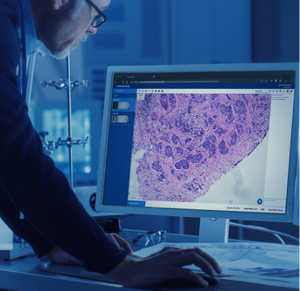AWS Startups Blog
Proscia Is Transforming Biomedical Research With Digital Pathology And AWS
Guest post by By Coleman Stavish, CTO, Proscia
 The COVID-19 pandemic has cast a spotlight on biomedical research. Every day, we read headlines about pharmaceutical companies and their latest vaccine developments, and we hear new recommendations for keeping ourselves healthy as researchers gain additional insight into the virus.
The COVID-19 pandemic has cast a spotlight on biomedical research. Every day, we read headlines about pharmaceutical companies and their latest vaccine developments, and we hear new recommendations for keeping ourselves healthy as researchers gain additional insight into the virus.
This research, like all investigation of disease, depends on data – patient samples, observations, narrative details, and much more. When researchers have the right data at their disposal, they can identify trends and patterns and draw comprehensive conclusions. Perhaps this sounds straightforward in theory. But in practice, accessing the volumes of data that researchers need is often easier said than done.
Consider that most patient samples, like tissue biopsies, currently lie in glass slides waiting to be viewed under a microscope. Now, imagine that a researcher is trying to access specific biopsies. Doing so is much more difficult and time consuming than running a quick search and waiting for results to appear. Similarly, what happens if researchers want to view data that isn’t in their immediate location? Believe it or not, they may be forced to wait for the necessary glass slides via snail mail or have them scanned and sent on a hard drive.
Proscia helps life sciences companies and research organizations overcome these problems as well as address the broader set of challenges that stem from microscope-based pathology. We’re a software company that is changing the way the world practices pathology to transform cancer research and diagnosis. Our digital pathology platform, called Concentriq, enables researchers to manage, analyze, and share high-resolution images of tissue biopsies, making them readily accessible for review, searchable for further investigation, and available for streamlined collaboration. Furthermore, organizations can use our platform to launch computational applications leveraging artificial intelligence to unlock new insights and drive powerful efficiencies. For these reasons and a host of others, many research organizations have been on the forefront of digital pathology adoption, and 10 of the top 20 pharmaceutical companies are now on Concentriq.
The Joint Pathology Center (JPC) is among the organizations that have gone digital. JPC, the premiere pathology reference center for the U.S. government, hosts the world’s largest repository of human tissue. This archive dates back to the Civil War, contains over 55 million glass slides in addition to other data, and has provided critical insight into our understanding of infectious disease and cancer; data from the repository was used to sequence the 1918 influenza virus that killed over 40 million people worldwide, and it can similarly help us to combat COVID-19.
JPC is making the transition to digital pathology to enable researchers, pathologists, and clinicians realize even more value from its data. As digitizing the world’s largest human tissue repository requires a robust software platform, JPC selected Proscia’s Concentriq as the foundation of its digital ecosystem. With Concentriq, JPC will provide its global network of researchers with intuitive access to its data and improve collaboration, enabling them to more easily analyze thousands of diseases and find new ways of fighting them.
Like all organizations adopting digital pathology, JPC needed to ground its digital ecosystem on best-of-breed infrastructure to provide a highly-performant experience. An average pathology image is 2GB, which is 2 to 10 times larger than a radiology image, like one that would typically come from an MRI or CT scan. These images are also typically ingested gradually, meaning that storage must rapidly scale to accommodate growing volumes of data.
To address this big data challenge, JPC turned to AWS. AWS is especially well-suited to handle the massive volume of data contained in pathology images, as it enables organizations to host growing workloads in a cost-effective way. Additionally, it offers out-of-the-box features to ensure the reliability, security, and access management required for managing sensitive healthcare information and distributed teams. These benefits explain why organizations are increasingly selecting AWS when shifting to digital pathology – and for digital initiatives involving large volumes of healthcare data more generally.
Specifically, Concentriq leverages several AWS services in delivering a scalable digital ecosystem to organizations like JPC. These include Amazon Relational Database Service (Amazon RDS) for PostgreSQL, Amazon Simple Storage Service (Amazon S3) and/or Amazon Elastic File System (Amazon EFS) for scalably storing pathology images, and Amazon Elastic Compute Cloud (Amazon Ec2) instances, with optional auto-scaling, for managing variable and demanding compute workloads. JPC also deployed Concentriq on AWS GovCloud so that it could meet the government’s strict security and compliance requirements.
With a leading image and data management platform grounded on best-of-breed infrastructure in place, JPC is now in prime position to capitalize on the full impact of its century-old data archive. This not only includes increasing access to the data but also using the data to build computational pathology applications leveraging artificial intelligence that establish diagnosis, prognosis, and personalized therapies for patients. Training and validating even a single computational pathology application requires massive volumes of images to ensure that it can account for the tremendous variability seen in practice, and JPC’s archive is unmatched in its ability to provide this data for countless diseases and use cases. As JPC delivers these applications, it can deploy them, along with other AI solutions, into its pathology practice with Concentriq.
Together, Proscia, JPC, and AWS are unleashing a new wave of biomedical research with endless potential to shape our understanding and diagnosis of current and future disease. To learn more about how Proscia is helping life sciences and other research organizations to accelerate breakthroughs with digital pathology, visit us here or follow our journey @ProsciaInc.